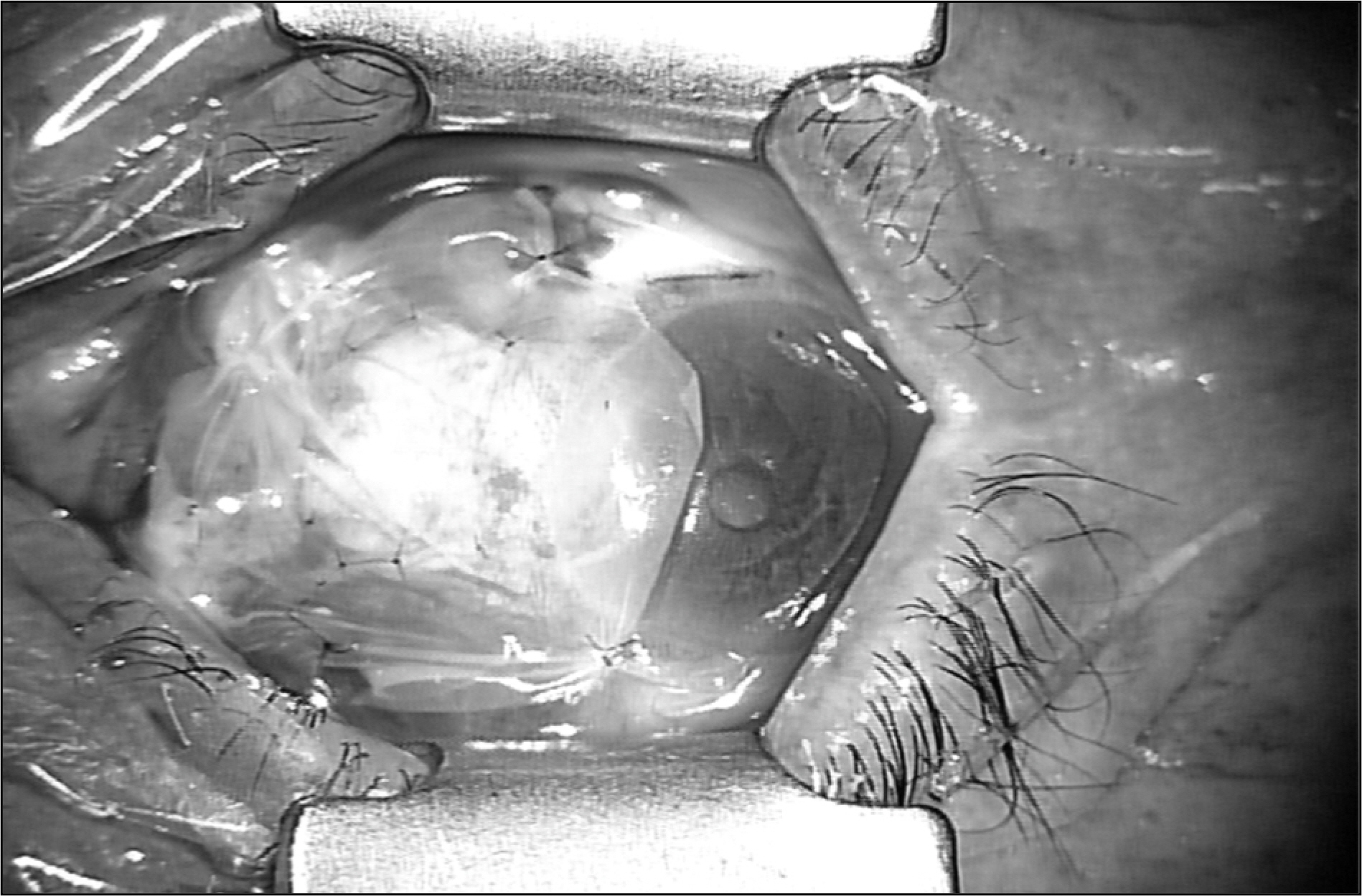J Korean Ophthalmol Soc.
2011 Feb;52(2):163-168.
Recurrence Rates of Conjunctival Autograft Transplantation With Aminiotic Membrane Transplantation in Primary Pterygium Surgery
- Affiliations
-
- 1Department of Ophthalmology, Ajou University School of Medicine, Suwon, Korea. yhs0816@naver.com
Abstract
- PURPOSE
To compare postoperative recurrence rates between conjunctival autograft transplantation alone and conjunctival autograft transplantation with amniotic membrane transplantation in primary pterygium surgery.
METHODS
The authors conducted a retrospective analysis of 66 eyes from 62 patients who underwent primary pterygium surgery from January 2001 to May 2009. Twenty three eyes underwent conjunctival autograft transplantation alone, 43 eyes underwent conjunctival autograft transplantation with amniotic membrane transplantation.
RESULTS
Recurrence of pterygium was observed in 5 of 23 eyes that received conjunctival autograft transplantation alone. There were 2 cases of recurrence of 43 eyes that received conjunctival autograft transplantation and amniotic membrane transplantation. No major complications such as necrotizing scleritis, sclera ulcer, or corneal perforation were observed in either group after surgery.
CONCLUSIONS
The present study showed that receiving both conjunctival autograft transplantation and amniotic membrane transplantation in pterygium surgery has a lower recurrence rate than conjunctival autograft transplantation alone.
Keyword
MeSH Terms
Figure
Reference
-
References
1. Donnenfeld ED, Perry HD, Fromer S, et al. Subconjunctival mitomycin C as adjunctive therapy before pterygium excision. Ophthalmology. 2003; 110:1012–6.
Article2. Hong SB, Oh SJ, Oh JH. The effects and complications of mitomycin-C for prevention of recurrence after pterygium operation. J Korean Ophthalmol Soc. 1998; 39:2013–8.3. Mastropasqua L, Carpineto P, Ciancaglini M, Enrico Gallenga P. Long-term results of intraoperative mitomycin C in the treatment of recurrent pterygium. Br J Ophthalmol. 1996; 80:288–91.4. Amano S, Motojyma Y, Oshika T, et al. Comparative study of intraoperative mitomycin C and beta irradiation in pterygium surgery. Br J Ophthalmol. 2000; 84:618–21.
Article5. Lee SH, Jeong HJ. Immune reactions in pterygium. J Korean Ophthalmol Soc. 1987; 28:927–33.6. Jaros PA, DeLuise VP. Pingueculae and pterygia. Surv Ophthalmol. 1988; 33:41–9.
Article7. Kim CH, Lee JK, Park DJ. Recurrence rates of amniotic membrane transplantation, conjunctival autograft and conjunctivolimbal autograft in primary pterygium. J Korean Ophthalmol Soc. 2009; 50:1780–8.
Article8. Manning CA, Kloess PM, Diaz MD, Yee RW. Intraoperative mitomycin in primary pterygium excision. A prospective, randomized trial. Ophthalmology. 1997; 104:844–8.9. Allan BD, Short P, Crawford GJ, et al. Pterygium excision with conjunctival autografting: an effective and safe technique. Br J Ophthalmol. 1993; 77:698–701.
Article10. Cho JW, Chung SH, Seo KY, Kim EK. Conjunctival mini-flap technique and conjunctival autotransplantation in pterygium surgery. J Korean Ophthalmol Soc. 2005; 46:1471–7.11. Prabhasawat P, Barton K, Burkett G, Tseng SC. Comparison of conjunctival autografts, amniotic membrane grafts, and primary closure for pterygium excision. Ophthalmology. 1997; 104:974–85.
Article12. Tan DT, Chee SP, Dear KB, Lim AS. Effect of pterygium morphology on pterygium recurrence in a controlled trial comparing conjunctival autografting with bare sclera excision. Arch Ophthalmol. 1997; 115:1235–40.
Article13. Mutlu FM, Sobaci G, Tatar T, Yildirim E. A comparative study of recurrent pterygium surgery: limbal conjunctival autograft transplantation versus mitomycin C with conjunctival flap. Ophthalmology. 1999; 106:817–21.
Article14. Barraquer JI, Binder PS, Buxton JN. Etiology and treatment of pterygium; Symposium on Medical and Surgical Diseases of the Cornea. Transactions of the New Orleans Academy of Ophthalmology. St. Louis: Mosby;1980. p. 167–78.15. Ozer A, Yildirim N, Erol N, Yurdakul S. Long-term results of bare sclera, limbal-conjunctival autograft and amniotic membrane graft techniques in primary pterygium excisions. Ophthalmologica. 2009; 223:269–73.
Article16. Kenyon KR, Tseng SC. Limbal autograft transplantation for ocular surface disorders. Ophthalmology. 1989; 96:709–22.
Article17. van Herendael BJ, Oberti C, Brosens I. Microanatomy of the human amniotic membrane. A light microscopic, transmission, and scanning electron microscopic study. Am J Obstet Gynecol. 1978; 131:872–80.18. Terranova VP, Lyall RM. Chemotaxis of human gingival epithelial cells to laminin. A mechanism for epithelial cell apical migration. J Periodontol. 1986; 57:311–7.19. Sonnenberg A, Calafat J, Janssen H, et al. Integrin alpha 6/beta 4 complex is located in hemidesmosomes, suggesting a major role in epidermal cell-basement membrane adhesion. J Cell Biol. 1991; 113:907–17.
Article20. Streuli CH, Bailey N, Bissel MJ. Control of mammary epithelial differentiation: basement membrane induces tissue-specific gene expression in the absence of cell-cell interaction and morphological polarity. J Cell Biol. 1991; 115:1383–95.
Article21. Na BK, Hwang JH, Kim JC, et al. Analysis of human amniotic membrane components as proteinase inhibitors for development of therapeutic agent for recalcitrant keratitis. Placenta. 1999; 20:453–66.
Article22. Solomon A, Pires RT, Tseng SC. Amniotic membrane transplantation after extensive removal of primary and recurrent pterygia. Ophthalmology. 2001; 108:449–60.
Article
- Full Text Links
- Actions
-
Cited
- CITED
-
- Close
- Share
- Similar articles
-
- Recurrence Rates of Amniotic Membrane Transplantation, Conjunctival Autograft and Conjunctivolimbal Autograft in Primary Pterygium
- Surgical Outcome of Primary Pterygium Excision with Conjunctival Autograft
- Clinical Outcomes between Amniotic Membrane Transplantation and Conjunctival Autograft Using Fibrin Glue for Pterygium Surgery
- Limbal-Conjunctival Autograft Transplantation for the Treatment of Primary Pterygium
- The Effect of Amniotic Membrane Transplantation for Pterygium Excision



